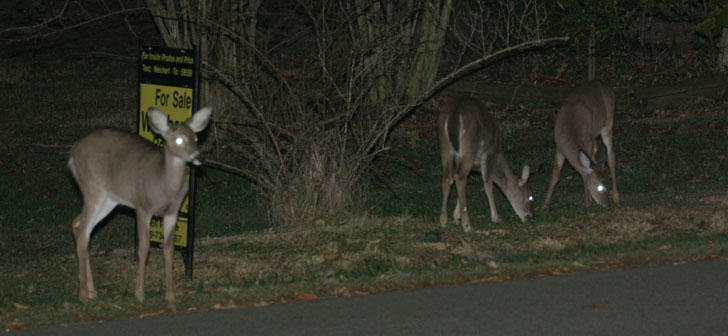
I’ve got, believe it or not, three book reviews (well, two and a half) coming up, that I want to space out, but at the moment I have nothing else handy to post. So we’ll go with some recent pics and soft music in the interim. You’ll have to provide the music.
 At left, a visitor just across the road late one night, who knew I was there but wasn’t too concerned – it’s possible to exploit this if you try. Just move slowly but casually, since animals respond more to actions than appearance. Let me put it this way: if you were auditioning for a part in a play and asked to “creep up on somebody,” what would it look like? Usually, exactly what most people do when trying to photograph animals. But the animals recognize this too. If instead, you were asked to “blend in with the crowd and not attract attention,” you’d be heading in the right direction. You’d look off into the distance and seem bored or preoccupied, wander aimlessly, and do anything significant only when no one was looking. You got it.
At left, a visitor just across the road late one night, who knew I was there but wasn’t too concerned – it’s possible to exploit this if you try. Just move slowly but casually, since animals respond more to actions than appearance. Let me put it this way: if you were auditioning for a part in a play and asked to “creep up on somebody,” what would it look like? Usually, exactly what most people do when trying to photograph animals. But the animals recognize this too. If instead, you were asked to “blend in with the crowd and not attract attention,” you’d be heading in the right direction. You’d look off into the distance and seem bored or preoccupied, wander aimlessly, and do anything significant only when no one was looking. You got it.
Deer rely on each other to provide cues to danger. Browsing deer have their heads down, wander aimlessly, and look around casually. Deer sensing danger put their heads high and stare, and they know predators not only do the same, they often approach very slowly in straight lines. We can actually imitate a deer and get away with it, despite our lack of big ears and dainty hooves (well, most of us.) Many animals can actually be approached obliquely, at an angle, because that sends the signals of the herd members, not a predator.
This is higher animals, mind you. Moving sideways is often worse for stalking insects, because their vision relies on differences and you may block out a new portion of background with lateral movement, whereas slow direct movement usually does not – think in terms of looking through pebbled glass. And I currently have my own mental image right now after saying, “stalking insects,” one which involves a teeny little rifle and the nerve to stand one’s ground when the rhinoceros beetle charges…
By the way, despite what many might think, the camera strobe meant absolutely nothing to these deer, as with most animals. I do remember a meerkat at the zoo, however, who kept looking at the ceiling when the flash went off, perhaps wondering about an approaching storm…




















































